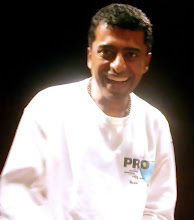
Funeral Beerdigung
couple of weeks ago, i saw "October 18, 1977 - cycle ", gerhard richter's set of 15 paintings at MOMA, New York (their permanent collection) along with my friend.
(quotes are from different web sites)
"black and white paintings are done by meticulously copying and blurring the photographs of dead Baader Meinhof group. this is all about context. it is a collection derived from imagery that would have been instantly recognizable to a German who viewed it in 1980s. in the late 80s the Red Army Faction was at its deadliest. The Baader Meinhof group abducted and bombed and murdered in public. And they are dead. "I was impressed by their energy, their uncompromising determination and their absolute bravery; but I could not find it in my heart to condemn the State for its harsh response." Richter has also described them as "people who died so young and so crazy, for nothing."
experiencing art benefits from contextualization. art by acknowledged masters like Goya, Monet, Picasso, and Rembrandt, for example. can't one enjoy their works for the pure emotions they stir, devoid of context? but our learning and appreciation is deepened by understanding the context in which the work arose. Richter's 'cycle' is cold, dreamy, and fundamentally, brilliantly, sad. His technique of blurring the details of the two-dimensional worlds of found photographs, renders life somehow inert. it certainly puts a distance between the viewer and the viewed; great tension is generated as we are pushed away from subjects that would normally draw us in. unlike old masters, the only way to discern more detail from Richter's work is for us to move further away. i think that was Richter's plan."
he has done landscapes in colour also; leaving one to wonder if they were some kind of joke.
Richter: "Of course my landscapes are not only beautiful or nostalgic, with a Romantic or classical suggestion of lost Paradises, but above all 'untruthful'... and by 'untruthful' I mean the glorifying way we look at Nature - Nature, which in all its forms is always against us, because it knows no meaning, no pity, no sympathy, because it knows nothing and is absolutely mindless: the total antithesis of ourselves, absolutely inhuman. Every beauty that we see in landscape is our projection; and we can switch it off at a moment's notice, to reveal only the appalling horror and ugliness". It appears that the ambivalence of the grey death paintings lurk behind his clear colour landscapes. The landscapes are beautiful but there is a desertedness, an anxious forbidding remoteness to them. Or do they just look that way because we have just walked through his paintings of murders, war, and atrocities?
thought provoking, of course; like the german film maker Herzog's view on nature; (in the documentary Grizzly Man (2005) where a nature lover lives among grizzly bears of alaska, and at last being killed by them). at one point Herzog explains over a close up shot of a grizzly's eyes that he sees nothing but "the overwhelming indifference of nature..."
my random thoughts:
-we humans are also a part of nature, not separate. nature is neutral. neither inhuman or human. planet is not homocentric.
-as he says, "every beauty that we see in landscape is our projection", so is ugliness. manifestation is the result of paying constant attention to what we want to see. two opposing perspectives.
-has nature(minus humans)began working against us? we humans are slowly tripping the balance at least for the last 100 years. is it what richter's ambivalence about?
-i think that is what his work's about, as a whole; considering his huge body of work of more than 30some years.












 anything we see has a meaning. sociopolitical, psychological, aesthetic and such. it has associations. sometimes representations. it exists as an ontological reality independent of our sensory perception. it is there as it is. it has an essence. it also has a subjective reality which we project on to it. our impression of it is based on our perception. which is real? both are. both exist. we observe it. we have an opinion about it. but it is not a permanent opinion. we perceive it in a particular time and space. time is embedded in it. it tells a story on one level. then after the story, it becomes silent. still. then it changes in to something else. a new story begins. some stories are short and subtle. minimal and sublime. swift and abstract. some are gross and bold. some do not sound like stories at all. but the subject continues to exist.
anything we see has a meaning. sociopolitical, psychological, aesthetic and such. it has associations. sometimes representations. it exists as an ontological reality independent of our sensory perception. it is there as it is. it has an essence. it also has a subjective reality which we project on to it. our impression of it is based on our perception. which is real? both are. both exist. we observe it. we have an opinion about it. but it is not a permanent opinion. we perceive it in a particular time and space. time is embedded in it. it tells a story on one level. then after the story, it becomes silent. still. then it changes in to something else. a new story begins. some stories are short and subtle. minimal and sublime. swift and abstract. some are gross and bold. some do not sound like stories at all. but the subject continues to exist.

















